
The Martini–Henry is a breech-loading single-shot rifle with a lever action that was used by the British Army. It first entered service in 1871, eventually replacing the Snider–Enfield, a muzzle-loader converted to the cartridge system. Martini–Henry variants were used throughout the British Empire for 47 years. It combined the dropping-block action first developed by Henry O. Peabody and improved by the Swiss designer Friedrich von Martini, combined with the polygonal rifling designed by Scotsman Alexander Henry.

The .303 British or 7.7×56mmR, is a .303-inch (7.7 mm) calibre rimmed tapered rifle cartridge. The .303 inch bore diameter is measured between rifling lands as is the common practice in Europe which follows the traditional black powder convention.
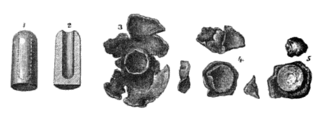
The term express was first applied to hunting rifles and ammunition beginning in the mid-19th century, to indicate a rifle or ammunition capable of higher than typical velocities. The early express cartridges used a heavy charge of black powder to propel a lightweight, often hollow point bullet, at high velocities to maximize point blank range. Later the express cartridges were loaded with nitrocellulose-based gunpowder, leading to the Nitro Express cartridges, the first of which was the .450 Nitro Express.

The .577/450 Martini–Henry is a black powder, centrefire rifle cartridge. It was the standard British service cartridge from the early 1870s that went through two changes from the original brass foil wrapped case to the drawn brass of two parts, the case and the primer. The .577/450 Martini–Henry was introduced with the Martini–Henry, in service it succeeded the .577 Snider cartridge and was used by all arms of the British armed forces as well British colonial forces throughout the British Empire until it was itself succeeded by the .303 British cartridge after an unsuccessful trial of a .402 calibre.
The .577 Nitro Express is a large-bore centerfire rifle cartridge designed for the purpose of hunting large game such as elephant. This cartridge is used almost exclusively in single-shot and double express rifles for hunting in the Tropics or hot climates in general and is a cartridge associated with the golden age of African safaris and Indian shikars.
.450 Nitro Express also known as the .450 Nitro Express 31⁄4-inch is a rifle cartridge designed for hunting dangerous game such as elephant, rhino, cape buffalo, lion, and leopard. This cartridge is used almost exclusively in double rifles for hunting in the tropics or hot climates in general and is associated with the Golden Age of African safaris and Indian shikars.
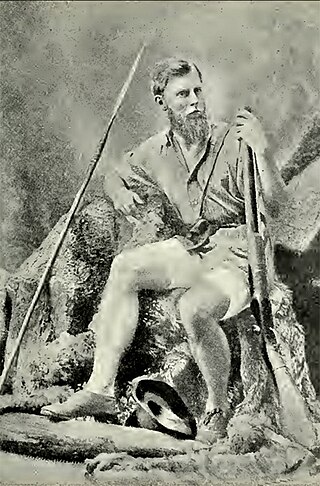
Four bore or 4 bore is a black powder caliber of the 19th century, used for the hunting of large and potentially dangerous game animals. The specifications place this caliber between the larger 2 bore and the smaller 6 bore rifles. This caliber was the quintessential elephant gun caliber of the black powder safari rifles. The caliber was also used for the Coffman cartridges used for starting large aero engines such as the Rolls-Royce Griffon as used in the later Marks of Supermarine Spitfire.
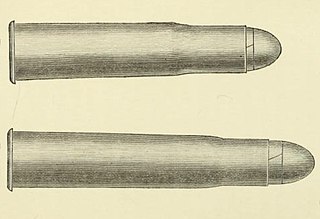
The .577/500 No. 2 Black Powder Express, also known as the 12.7mm British No. 2, is a British centerfire fire rifle cartridge.

The .500 Nitro Express is a rifle cartridge designed for hunting large and dangerous game animals in Africa and India. This cartridge was primarily designed for use in double rifles though various single shots were produced on the Farquarson action and at least one major company (Heym) produced it in bolt-action configuration. It was commonly available in two lengths: a 3.00 in (76 mm) and a 3.25 in (83 mm) version.
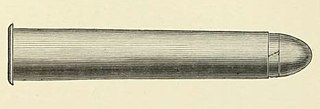
The .500 Black Powder Express was a series of Black powder cases of varying lengths that emerged in the 1860s.

The .450/400 Nitro Express is a Nitro Express rifle cartridge that is produced in three case lengths: 23⁄8-inches, 3 inches and 31⁄4-inches, and is intended for use in single shot and double rifles. The 3-inch and 31⁄4-inch versions are considered classic Nitro Express cartridges.
The .400 Jeffery Nitro Express or .450/400 Nitro Express 3-inch is a medium bore, bottlenecked, Nitro Express cartridge designed by W.J. Jeffery & Co in 1902, intended for use in single shot and double rifles.
The .577 Black Powder Express is a series of black powder cartridges of varying lengths including 21⁄2-inch, 23⁄4-inch, 3-inch and 31⁄4-inch.
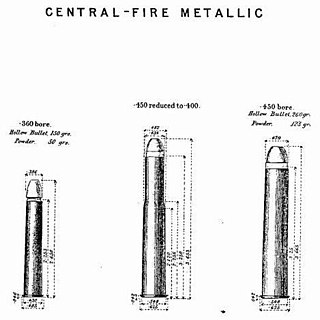
The .450/400 Black Powder Express cartridges were black powder rifle cartridges introduced in the United Kingdom in the 1880s.
The .500/450 3+1⁄4-inch Magnum Black Powder Express, is a centerfire rifle cartridge developed in Britain.
The .400 Purdey, also known as the .400 3-inch Straight and .400 Purdey Light Express 3-inch, is an obsolete rifle cartridge developed by James Purdey & Sons.
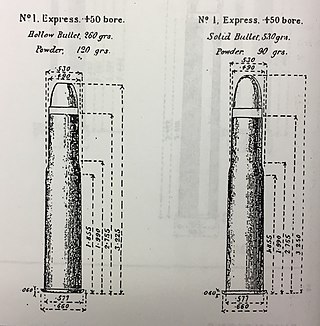
The .500/450 No. 1 Black Powder Express, known in its day as the .500/450 No. 1 Express, was a centerfire rifle cartridge developed by Westley Richards and introduced in the late 1870s.

The .461 No 1 Gibbs and the .461 No 2 Gibbs are two obsolete proprietary rifle cartridges developed in 19th century Britain.
The .375/303 Westley Richards Accelerated Express, also known as the .375/303 Axite, is an obsolete medium bore rifle cartridge.
The 20/577 Alexander Henry, also known as 20/577 Express, is an obsolete rifle cartridge.














